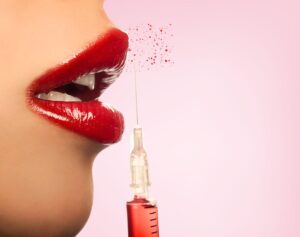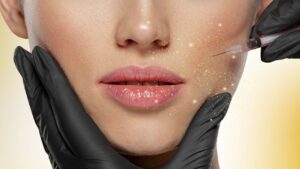Ultimate Lip Enhancement Guide
Explore expert insights, tips, and treatments for achieving your ideal results
KEY TAKEAWAYS
- Lip enhancement can be done with non-surgical options like fillers or surgical procedures — the right choice depends on how long you want the results to last and how much downtime you’re comfortable with.
- Creating natural-looking results means thinking about lip proportions and how they fit with the rest of your face — often guided by principles like the golden ratio.
- Fillers are great for subtle, temporary changes with minimal recovery, while surgery offers more permanent results but requires longer healing time.
- Choosing an experienced provider who understands facial anatomy is crucial for getting safe, natural-looking, and balanced results.
- Knowing what to expect after treatment — from swelling to touch-up timelines — helps you protect your results and feel confident in your outcome.
Explore Lip Enhancement

Hyaluronic Acid & Weight Gain From Water Retention
What is Hyaluronic Acid? Hyaluronic acid. You've probably heard the name buzzing around the skincare industry. But what exactly is it? Often referred to as hyaluronan or hyaluronate, this gooey,

17 Tips to Know Before First Time Lip Fillers
Quick Answer: Your jaw may be popping on one side due to issues with the temporomandibular joint…

Where Not to Inject Botox
Quick Answer Botox also know as botulinum toxin is a very popular cosmetic treatment or an aesthetic medicine that can improve the appearance of your face. Injection of botulinum toxin

What Not to Do After Lip Fillers: A Comprehensive Guide to Lip Filler Aftercare
Excited to have fuller lips? Lip filler injections can make it happen for you! In this article “what not to do after lip fillers”, you’ll find out all the details

What is Russian Lip Filler? Discover the Magic
Are you curious about Russian lips and this filler technique? Wondering what it is, how it works, and how different it is from traditional dermal filler and of course what

Can You Mix Different Lip Fillers?
Lip fillers have become one of the most popular procedures for people looking to enhance the appearance of their lips. It’s also a popular procedure for men and women who

Lip Fillers for Men – Are They a Good Option for You?
Are you a man looking to enhance your appearance without surgery? Non-surgical lip fillers for men may be just what you need. Hollywood’s leading men have been using these treatments

Restylane vs Juvederm – Which Should You Choose ?
Plastic surgery is not the only choice for a facelift or facial rejuvenation. Juvéderm and Restylane are two of the most popular non-invasive dermal filler treatments for women and men

The Best Way To Reduce Lip Filler Swelling Stages
Everything You Need to Know – Lip Filler Swelling Stages Have you ever thought about getting lip fillers to plump up your pout? It’s a popular cosmetic procedure, but it
Choosing the right lip enhancement approach is a significant decision. The wrong choice might not align with your aesthetic vision or could lead to unnecessary discomfort, while the ideal enhancement can subtly boost your features and confidence. How do you determine the best fit for your unique situation?
This guide explores the essential factors in selecting lip enhancement methods, covering procedure types, comfort levels, desired outcomes, and recovery expectations. You’ll gain the knowledge needed to make an informed decision and effectively enhance your natural beauty. Let’s find your perfect match!
Surgical vs Non-Surgical Options: Understanding Your Choices
Understanding the fundamental differences between surgical and non-surgical lip enhancement is the first step in making an informed choice. Each path caters to different needs, desired levels of change, and commitment preferences.
Non-Surgical Enhancements: Flexibility and Minimal Downtime
Non-surgical options primarily involve minimally invasive techniques with little to no required recovery time.
- Lip Fillers: The most common method uses injectable substances, typically hyaluronic acid (HA). HA fillers add immediate volume and shape, offering customizable results from subtle to noticeable. They provide a temporary solution, usually lasting six months to a year, requiring touch-ups for maintenance. Why HA? It’s naturally found in the body, attracts water for hydration, and offers the flexibility of being adjustable or dissolvable.
- Minimally Invasive Lip Lifts: Some techniques use small incisions (e.g., under the nose) to elevate the upper lip, offering a more lasting effect than fillers but less invasively than traditional surgery.
Consider Non-Surgical If: You prefer reversible options, want to experiment with your look, desire minimal side effects, or cannot accommodate significant downtime.
Surgical Enhancements: Permanent Changes and Longer Recovery
Surgical lip enhancement involves more invasive procedures, often yielding permanent results but requiring a longer recovery period.
- Autologous Fat Grafting: Uses your own body fat, harvested from another area and injected into the lips. Offers potentially durable, natural-feeling results but involves two procedure sites and more variability in outcome and recovery than fillers.
- Lip Implants: Silicone or other biocompatible materials are inserted to provide lasting volume and structure. This creates a significant and permanent alteration.
- Surgical Lip Lifts/Reductions: Procedures to permanently alter the shape, position, or size of the lips through tissue removal or repositioning.
Consider Surgical If: You seek a permanent change, desire dramatic results not achievable with fillers alone, and are prepared for the associated risks, anesthesia, and necessary recovery time.
Making the Initial Decision
Your choice between surgical and non-surgical methods hinges on your aesthetic goals (subtle vs. dramatic, temporary vs. permanent), tolerance for downtime, and comfort level with procedural invasiveness. Reflecting on these core factors provides a foundation for further refinement.
Once you understand the basic types, let’s delve deeper into how fillers specifically work to achieve different looks.
How Lip Fillers Work: Tailoring to Your Goals
Grasping how lip fillers function helps align the treatment with your specific aesthetic objectives. Whether aiming for subtle volume, redefined shape, or a more striking pout, understanding filler characteristics is key to a satisfying outcome.
Achieving a Subtle, Natural Look
For a natural appearance, subtlety is paramount. Hyaluronic acid fillers are often preferred for their ability to offer a gentle lift, enhance soft curves, and boost hydration without looking exaggerated. Because HA integrates well with tissues, results typically blend effortlessly, providing an understated enhancement.
Creating a More Dramatic Effect
If you’re aiming for a more dramatic effect, the Russian Lip technique might be worth exploring.
If a more pronounced change is desired—perhaps for a special event or a consistently bolder look—thicker fillers or larger volumes might be considered. These can provide firmer structure and definition.
Careful consultation with your provider is crucial to ensure these choices maintain overall lip proportion harmony with your other facial features. Discussing your vision clearly helps them select the right product and technique.
Guidance for First-Timers
Feeling apprehensive before a first treatment is normal — here are 17 useful tips to know before your first time getting lip fillers.. A skilled provider can ease concerns by suggesting a gradual approach. Starting with smaller volumes allows you to comfortably adjust to your new look, with the option to add more later if desired.
Considering Lifestyle and Longevity
Your daily activities and maintenance preferences also matter. Active individuals or those preferring less frequent appointments might inquire about fillers known for longer duration (though still temporary). While potentially reducing touch-up frequency, understand that longer-lasting fillers may be less easily reversible.
Beyond filler mechanics, several personal factors influence the ideal enhancement strategy.
Factors Influencing Your Treatment Choice
Selecting the optimal lip enhancement requires balancing your desired aesthetic, practical considerations, and personal preferences. Let’s refine the decision-making process by looking at key influencing factors.
Defining Your Desired Outcome
- Natural vs. Noticeable: Are you seeking a subtle refinement or a distinct transformation? Non-surgical fillers excel at adaptable, natural-looking results. Surgical options are better suited for significant, permanent changes in volume or shape (like correcting major asymmetry or performing a lip lift).
- Temporary vs. Permanent: Fillers offer flexibility and are temporary. Surgery provides lasting results but requires a greater initial commitment and acceptance of permanence.
Lifestyle and Practicalities
- Recovery Time: Non-surgical fillers involve minimal downtime (mostly swelling/bruising for a few days). Surgical procedures require a more extended recovery period. Consider your ability to take time off work or social activities.
- Maintenance Commitment: Fillers require periodic touch-ups (typically every 6-12+ months) to maintain results. Surgery is often a one-time procedure, though revisions are possible. Evaluate your willingness and budget for ongoing maintenance versus a single, larger upfront investment.
- Special Events: For occasions like weddings, fillers offer predictable results with short recovery, but timing is key. Schedule well in advance to allow swelling to resolve.
Achieving a beautiful result also involves understanding aesthetic principles, particularly lip proportions.
Ideal Lip Proportions and Facial Harmony
While personal preference reigns supreme, understanding common aesthetic principles can help guide your lip enhancement choices towards results that create facial balance. It’s less about rigid rules and more about achieving harmony.
The Concept of Ideal Proportions
Aesthetic guidelines often reference concepts like the golden ratio or general observations about pleasing proportions. A frequently cited (though not universally required) guideline suggests the lower lip might be slightly fuller than the upper lip (around a 1:1.6 ratio) for a classically balanced look. Other factors include a defined cupid’s bow and clear vermillion borders.
However, the primary goal is enhancing your features harmoniously, not conforming to a mathematical ideal. Trends also evolve, and individual beauty varies widely.
How Proportions Influence Treatment
- Subtle Adjustments: Fillers are excellent for refining proportions—adding slight volume to the upper or lower lip, enhancing the cupid’s bow, or defining borders for a more balanced look without drastic changes.
- Significant Reshaping: If your natural proportions differ significantly from your desired outcome (e.g., needing substantial upper lip elevation or volume correction), surgical options like a lip lift or implants might be discussed alongside or instead of fillers.
- Correcting Asymmetry: Both fillers and surgery can address asymmetry, depending on the cause and degree.
Discussing proportions with your provider helps ensure the enhancement complements your overall facial structure. They can assess your anatomy and explain how different techniques can achieve proportionate, aesthetically pleasing results tailored to you.
Knowing the options and aesthetic considerations, who typically benefits most from these procedures?
Who Is a Good Candidate?
Determining candidacy for lip enhancement involves assessing health, expectations, and suitability for specific procedures.
General Candidacy Factors
- Good Health: Candidates should generally be in good physical health without uncontrolled medical conditions that could impair healing.
- Realistic Expectations: Understanding the possibilities and limitations of each procedure is crucial for satisfaction.
- Motivations: Seeking enhancement for personal reasons, rather than external pressure, usually leads to better outcomes.
Specific Candidacy: Non-Surgical vs. Surgical
- Non-Surgical (Fillers): Ideal for those seeking temporary volume, shape refinement, or hydration boost. Suitable for most healthy adults wanting flexibility and minimal downtime. Contraindications might include certain allergies, skin infections near the lips, or specific medical conditions.
- Surgical (Implants, Lifts, Fat Grafting): Best for those desiring permanent, significant changes in shape or volume. Candidates must be prepared for surgery, anesthesia risks, and a longer recovery. Good tissue quality and specific anatomical needs (e.g., elongated philtrum for a lip lift) are often considerations.
A thorough consultation with a qualified provider is necessary to determine your specific candidacy for any procedure, discuss potential risks, and confirm it aligns with your health profile.
If you proceed with fillers, here’s what to anticipate during the initial adjustment phase.
Lip Filler Results: What to Expect Post-Treatment
Undergoing lip filler treatment for the first time involves an adjustment period. Knowing what’s normal helps manage expectations and navigate the process smoothly.
Immediately After Treatment
Expect immediate fullness, but also anticipate swelling — here’s the best way to reduce it step-by-step this is a normal reaction. Your lips might appear larger than the final result for the first few hours to days. Minor redness or bruising at injection sites is also common.
Patience is essential as initial swelling obscures the true enhancement for a short time.
The First Week: Settling and Softening
During the first week, swelling gradually subsides. Lips might feel firm, slightly tender, or have small bumps initially; this typically resolves as the filler integrates. By week’s end, much of the swelling should be gone, and lips start feeling softer and more natural.
Weeks Two and Three: Revealing the Final Look
By weeks two and three, the filler usually settles fully, integrating with your tissues. This is when you’ll appreciate the final shape and volume. Remember, HA fillers typically last six months to a year (or more, depending on the product and individual factors like metabolism). Gradual softening over time is normal; discuss touch-ups with your provider to maintain your desired look.
Recognizing Normal vs. Concerning Signs
Mild swelling, bruising, and tenderness are normal. However, contact your provider promptly if you experience:
- Excessive or worsening pain, swelling, or redness
- Significant asymmetry developing after initial swelling
- Blanching (whiteness) of the skin, coolness, or unusual skin discoloration
- Signs of infection (pus, heat, fever)
- Hard lumps persisting beyond a few weeks
These could indicate complications requiring attention.
Supporting Your Results with Aftercare
Follow your provider’s aftercare instructions carefully. Common advice includes:
- Avoiding strenuous exercise, excessive heat, and alcohol for 24-48 hours
- Staying hydrated
- Applying cold compresses gently to manage swelling (as directed)
- Avoiding firm pressure or massage unless specifically instructed
Good aftercare supports optimal healing and results. Discuss your maintenance plan during follow-up.
While understanding results is key, let’s also address common myths surrounding lip enhancement.
Lip Enhancement Myths and Misconceptions
Myth: “Lip augmentation always looks fake and is only about making lips huge.”
Reality: This is a common misconception. While some individuals desire very full lips, skilled lip enhancement focuses on enhancing natural beauty and achieving results appropriate for the individual’s features. Modern techniques and fillers allow for subtle improvements in definition, symmetry, hydration, and balance, not just sheer volume. A talented injector aims for results that harmonize with the face, whether the goal is subtle or more noticeable.
Takeaway: Well-executed lip augmentation should be tailored to your aesthetic goals, aiming for balance and confidence, regardless of the desired volume level.
Achieving such tailored results heavily depends on the practitioner you choose.
Choosing a Skilled Provider: Your Most Important Decision
Selecting a qualified and skilled provider for lip enhancement is paramount for ensuring safety, satisfaction, and achieving your desired aesthetic. This choice significantly impacts your experience and outcome.
Research and Verify Credentials
Begin by researching professionals specializing in facial aesthetics. Look for board-certified dermatologists, plastic surgeons, or highly experienced aesthetic nurses or physician assistants operating under appropriate medical supervision. Verify their credentials, state licensure, and experience specifically with lip injections and facial anatomy.
Assess Reputation and Past Work
Read reviews and testimonials from previous clients on independent platforms. Examine before-and-after photo galleries critically: Do the results align with your aesthetic? Do they demonstrate skill with various lip types and desired outcomes (both subtle and more dramatic)? Look for consistency and natural-looking results (unless otherwise requested by the patient).
Prioritize the Consultation
Schedule consultations with your top candidates. Use this time to:
- Discuss their experience, preferred techniques, and filler choices for lips.
- Observe how they assess your facial features and listen to your goals.
- Ask detailed questions about the procedure, products, risks, longevity, costs, and aftercare.
- Gauge their communication style and whether you feel comfortable and understood.
A good provider welcomes questions and educates you thoroughly.
Trust Your Instincts and Confirm Safety Protocols
Pay attention to your comfort level. Avoid providers who seem rushed, dismissive, or pushy. Ensure the clinic follows strict hygiene and safety standards, is equipped to handle potential complications, and makes you feel confident in their professionalism.
Understand the Final Plan
Before proceeding, ensure you clearly understand the agreed-upon treatment plan: the specific filler, amount, placement strategy, expected outcome, and total cost. Realistic expectations are key.
Choosing the right injector is an investment in your safety and the quality of your results—invest the time to choose well.
Looking ahead, what might the evolution of lip treatments entail?
Future of Lip Enhancement: Trends and Innovations
The field of lip enhancement continues to evolve, driven by technological advancements and shifting aesthetic preferences. Staying informed helps you navigate future options.
Emphasis on Naturalism and Personalization
The trend towards subtle, natural-looking results persists. Future developments in dermal fillers likely focus on improved tissue integration, varied textures for different effects (e.g., hydration vs. structure), and potentially longer-lasting formulations that still maintain a natural feel. Customized treatment plans, considering individual anatomy and goals with greater precision, will remain central.
Refinements in Surgical Techniques
For those seeking permanent changes, surgical techniques like lip lifts, fat grafting, and implants may see refinements aimed at enhancing predictability, minimizing scarring, reducing recovery times, and improving the feel and safety of implants.
Combination Therapies
Sophisticated approaches combining modalities may become more common—perhaps using foundational support (structural filler or minimal surgery) paired with softer fillers for surface refinement and hydration, offering tailored results with managed downtime.
Lifestyle Alignment Remains Crucial
Regardless of future innovations, aligning treatment choices with your lifestyle, budget, tolerance for downtime, and long-term aesthetic vision will remain paramount. Open communication with your provider about evolving options and your personal context is key.
Having covered the journey from options to future trends, let’s summarize.
Conclusion: Empowered Decisions for Your Beauty Journey
You’ve explored the comprehensive landscape of lip enhancement, from differentiating fillers and surgical options to understanding results and the critical role of choosing a skilled professional. Armed with this knowledge, you can make informed, empowered decisions that align with your personal aesthetic aspirations.
Continue learning by exploring related topics like advancements in facial aesthetics or detailed aftercare protocols. Embrace the process with confidence, stay informed, and choose the path that best reflects your unique beauty goals.
FAQ’s
Q: What are the main ingredients in lip fillers?
A: Most modern lip fillers are primarily composed of hyaluronic acid (HA), a sugar molecule naturally present in the skin that binds water. Its role is to provide volume and hydration, resulting in a fuller, smoother lip appearance.
Q: How long can I expect the effects of lip fillers to last?
A: Results from HA lip fillers typically last from six months to over a year. Longevity depends heavily on the specific filler product used (cross-linking, concentration), the amount injected, the treatment area’s mobility, and individual factors like metabolism.
Q: Is the lip filler procedure painful?
A: Discomfort is managed effectively. Providers use potent topical numbing creams, and many fillers contain pre-mixed lidocaine (a local anesthetic). While you might feel brief pinching or pressure during injections, most patients find the procedure tolerable.
Q: Are there significant risks associated with lip fillers?
A: Common, temporary side effects include swelling, bruising, redness, and tenderness. Less common risks include infection, allergic reactions, lumpiness, or asymmetry. A rare but serious risk is vascular occlusion (filler blocking a blood vessel), which requires immediate treatment. Choosing a qualified, experienced injector who understands facial anatomy and uses safe techniques drastically minimizes significant risks.
Q: How do I choose the right lip filler for me?
A: There’s no single “best” filler; the ideal choice depends on your goals (e.g., subtle hydration vs. defined volume), lip structure, and desired outcome. Fillers vary in thickness, flexibility, and longevity. A thorough consultation with a qualified aesthetic provider is essential. They will assess your lips, discuss your wishes, and recommend the most suitable filler(s) to achieve your specific aesthetic goals safely and effectively.
